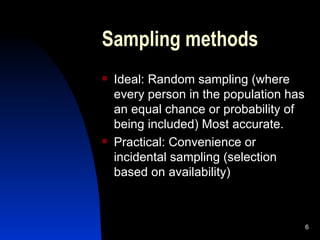HPPR404 Unit 5
- 1. HPPR 404 Research and Evaluation Sherrell Steele Research Decisions and Data Collection
- 2. Objectives List three key questions to ask prior to research Differentiate between formal/informal research Explain sampling methods esp. probability sampling Define and defend high research standards: accuracy, precision, reliability, validity List the eight steps of research design
- 3. Before research starts ask: What do we already know? Where are the gaps in our information? What other research exists to fill the gaps?
- 4. Formal vs. Informal Formal: systematic, fully representative sample e.g. surveys Informal: variable, unrepresentative sample e.g. personal interviews In between: e.g. partially systematic, purposefully selected sample e.g. focus groups
- 5. Representative sample Page 85 in text: When a sample is representative, it has the same distribution of characteristics as the population from which it was drawn. e.g. Voters in Victoria
- 6. Sampling methods Ideal: Random sampling (where every person in the population has an equal chance or probability of being included) Most accurate. Practical: Convenience or incidental sampling (selection based on availability)
- 7. High research standards Accuracy (error free data) Precision (exact results) Reliability (research can be repeated with exactly the same results) Validity (the research questions tests what needs to be tested and does not “dig up” unrelated data
- 8. Validity External validity: how representative or transferrable are the results? Internal validity: Are we measuring what we think we’re measuring? Face validity: Does the research appear to measure what we want to measure in an obvious way? Content validity: How comprehensive are the research measures? Predictive or criterion validity: How sound is the research measure compared to an external standard?
- 9. 8 step research process 1. Define research problem 2. Review the literature 3. Develop research question or hypothesis 4. Determine research methodology 5. Collect data 6. Analyze data 7. Make recommendations 8. Replicate studies (future benchmarks)
- 10. Summary and conclusions Sampling methods esp. (systematic, fully representative) probability sampling Key terms: accuracy, precision, reliability, validity Eight steps of research design
Editor's Notes
- #2: Hello students: Here are the slides for Week 5.
- #3: Here are the main objectives of chapter 5.
- #4: While the impulse is to move to research implementation, it is wise to spend time at the front end of a research project and ask some basic questions such as…
- #5: There are two approaches to research: Formal and informal. It’s also possible to consider hybrid or blended models.
- #6: One important factor in quality assurance is establishing a representative sample.
- #7: The ideal form of sampling is probability sampling. It is the most accurate and rigorous form of sampling but can be time consuming and expensive to achieve. In probability sampling care is taken to capture the complete audience set and then survey or question every nth person in that set, be that every 5 th , 10 th or 20 th person in the list. Let’s suppose that I wanted to examine the attitudes and opinions of public relations students across Canada. It would take some time for me to gather every name of every student at every institution in Canada. I would then send a survey to every 10 th or 20 th person on my list, depending on the size of sample I needed to be statistically valid. We call this probability sampling because every student has an equal chance of being called on to complete the survey. A more common approach is convenience sampling or incidental sampling. This is a more economical approach. Referring to my prior example, I might (for convenience) ask the attitudes and opinions of University of Victoria public relations students because they are easy to reach. Here I would make the assumption that they are representative of public relations students across Canada. Would this be a valid assumption?
- #8: We use the following terms to describe the quality of our research. Quality research is accurate, precise, reliable and valid.
- #9: There are five tests for validity.
- #10: Here are the eight steps to the formal research process.
- #11: Wrapping up, the key concept of this chapter is sampling and the key reseacrh terms are accuracy, precision, reliability and validity. We will use these terms throughout the course when commenting on the quality of research. That concludes the slides for week 5. Bye for now!









